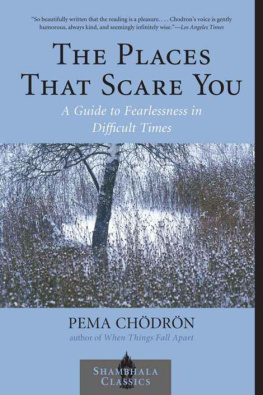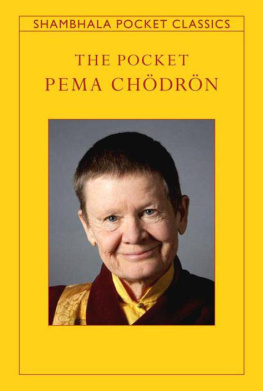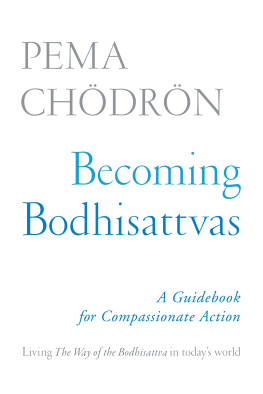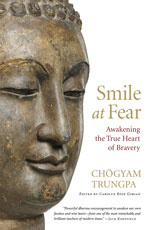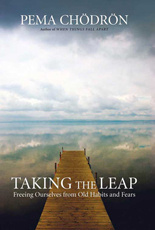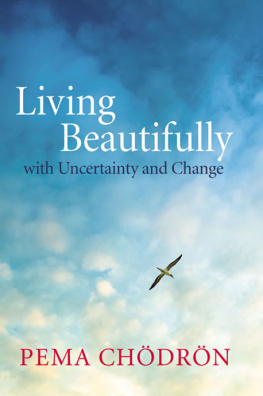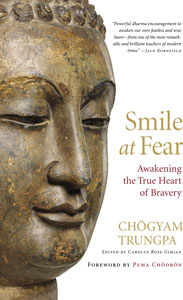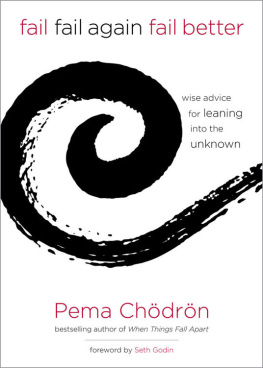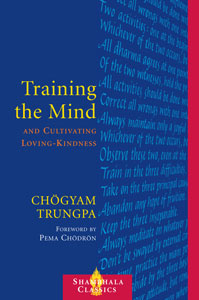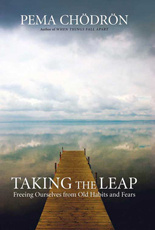The Places That Scare You

A GUIDE TO FEARLESSNESS
IN DIFFICULT TIMES
P EMA C HDRN

S HAMBHALA
Boston
2010
Shambhala Publications, Inc.
Horticultural Hall
300 Massachusetts Avenue
Boston, Massachusetts 02115
www.shambhala.com
2001 by Pema Chdrn
Epigraph in chapter 16 from Timely Rain by Chgyam Trungpa. From Timely Rain by Chgyam Trungpa. 1972, 1983, 1998 by Diana J. Mukpo. Reprinted by arrangement with Shambhala Publications, Inc., Boston, MA, 02115.
Four Limitless Ones chant as presented in appendix 2 is translated by the Nland Translation Committee.
Translation of The Root Text of the Seven Points of Training the Mind 1981, 1986 by Chgyam Trungpa; revised translation 1993 by Diana J. Mukpo and the Nland Translation Committee. All rights reserved.
No part of this book may be reproduced in any form or by any means, electronic or mechanical, including photocopying, recording, or by any information storage and retrieval system, without permission in writing from the publisher.
The authors proceeds from this book will be donated to Gampo Abbey, Pleasant Bay, Nova Scotia, Canada B0E 2P0.
THE LIBRARY OF CONGRESS CATALOGS THE PREVIOUS EDITION OF THIS BOOK AS FOLLOWS:
Chdrn, Pema.
The places that scare you: a guide to fearlessness in difficult times / Pema Chdrn.1st ed.
p. cm.
Includes bibliographical references.
eISBN 978-0-8348-2115-6
ISBN 978-1-57062-409-4
ISBN 978-1-57062-921-1
ISBN 978-1-59030-265-1
1. Religious lifeBuddhism. 2. BuddhismDoctrines. I. Title.
BQ5410 .C433 2001 294.3444 DC 212001020584
To the Sixteenth Karmapa, Rangjung Rigpe Dorje, Dilgo Khyentse Rinpoche, and Chgyam Trungpa Rinpoche, who taught me what it means to be fearless.
Confess your hidden faults.
Approach what you find repulsive.
Help those you think you cannot help.
Anything you are attached to, let it go.
Go to places that scare you.
ADVICE FROM HER TEACHER TO THE TIBETAN YOGINI MACHIK LABDRN
CONTENTS
ACKNOWLEDGMENTS
T HERE ARE FIVE PEOPLE whom I particularly want to thank for helping bring this book to life: my monastic brother Tingdzin tro, whose work on my talks was invaluable; Tamar Ellentuck, who was an excellent and loyal secretary to me through some very difficult times; Gigi Sims, transcriber extraordinaire; my good friend Helen Tworkov, who gave me the perfect place to write; and most of all, my longtime friend and editor, Emily Hilburn Sell, who put her whole heart into this book, extending herself with fearless warriorship.
I would also like to thank the many other people who have transcribed my talks over the past five years: Migme Chdrn, Lynne Van de Bunte, Eugene and Helen Tashima, Susan Stowens, Alexis Shaw, Bill and Eileen Fell, Rohana Greenwood, and Barbara Blouin.
I wish to thank Soledad Gonzlez for her loving-kindness.
My profound appreciation goes to Joko Beck and Ezra Bayda, whose work has had a major influence on me. In particular I want to acknowledge Ezras influence in the chapter on meditation.
Finally, I express my heartfelt gratitude to my living teachers, Dzigar Kongtrul Rinpoche and Sakyong Mipham Rinpoche. They are generous enough to continually show me the nature of my mind and reveal my hidden faults.
Prologue
W HEN I TEACH, I begin with a compassionate aspiration. I express the wish that we will apply the teachings in our everyday lives and thus free ourselves and others from suffering.
During the talk, I encourage the audience to keep an open mind. This is often likened to the wonder of a child seeing the world without preconceptions. As the Zen master Suzuki Roshi put it, In the beginners mind there are many possibilities, but in the experts there are few.
At the end of the talk, I dedicate the merit of the occasion to all beings. This gesture of universal friendship has been likened to a drop of fresh springwater. If we put it on a rock in the sunshine, it will soon evaporate. If we put it in the ocean, however, it will never be lost. Thus the wish is made that we not keep the teachings to ourselves but use them to benefit others.
This approach reflects what are called the three noble principles: good in the beginning, good in the middle, good at the end. They can be used in all the activities of our lives. We can begin anything we dostart our day, eat a meal, or walk into a meetingwith the intention to be open, flexible, and kind. Then we can proceed with an inquisitive attitude. As my teacher Chgyam Trungpa Rinpoche used to say, Live your life as an experiment.
At the end of the activity, whether we feel we have succeeded or failed in our intention, we seal the act by thinking of others, of those who are succeeding and failing all over the world. We wish that anything we learned in our experiment could also benefit them.
In this spirit, I offer this guide on the training of the compassionate warrior. May it be of benefit at the beginning, in the middle, and at the end. May it help move us toward the places that scare us. May it inform our lives and help us to die with no regrets.
The Excellence of Bodhichitta
It is only with the heart that one can see rightly; what is essential is invisible to the eye.
ANTOINE DE SAINT-EXUPRY
W HEN I WAS ABOUT SIX YEARS OLD I received the essential bodhichitta teaching from an old woman sitting in the sun. I was walking by her house one day feeling lonely, unloved, and mad, kicking anything I could find. Laughing, she said to me, Little girl, dont you go letting life harden your heart.
Right there, I received this pith instruction: we can let the circumstances of our lives harden us so that we become increasingly resentful and afraid, or we can let them soften us and make us kinder and more open to what scares us. We always have this choice.
If we were to ask the Buddha, What is bodhichitta? he might tell us that this word is easier to understand than to translate. He might encourage us to seek out ways to find its meaning in our own lives. He might tantalize us by adding that it is only bodhichitta that heals, that bodhichitta is capable of transforming the hardest of hearts and the most prejudiced and fearful of minds.
Chitta means mind and also heart or attitude. Bodhi means awake, enlightened, or completely open. Sometimes the completely open heart and mind of bodhichitta is called the soft spot, a place as vulnerable and tender as an open wound. It is equated, in part, with our ability to love. Even the cruelest people have this soft spot. Even the most vicious animals love their offspring. As Trungpa Rinpoche put it, Everybody loves something, even if its only tortillas.
Bodhichitta is also equated, in part, with compassionour ability to feel the pain that we share with others. Without realizing it we continually shield ourselves from this pain because it scares us. We put up protective walls made of opinions, prejudices, and strategies, barriers that are built on a deep fear of being hurt. These walls are further fortified by emotions of all kinds: anger, craving, indifference, jealousy and envy, arrogance and pride. But fortunately for us, the soft spotour innate ability to love and to care about thingsis like a crack in these walls we erect. Its a natural opening in the barriers we create when were afraid. With practice we can learn to find this opening. We can learn to seize that vulnerable momentlove, gratitude, loneliness, embarrassment, inadequacyto awaken bodhichitta.
An analogy for bodhichitta is the rawness of a broken heart. Sometimes this broken heart gives birth to anxiety and panic, sometimes to anger, resentment, and blame. But under the hardness of that armor there is the tenderness of genuine sadness. This is our link with all those who have ever loved. This genuine heart of sadness can teach us great compassion. It can humble us when were arrogant and soften us when we are unkind. It awakens us when we prefer to sleep and pierces through our indifference. This continual ache of the heart is a blessing that when accepted fully can be shared with all.
Next page
